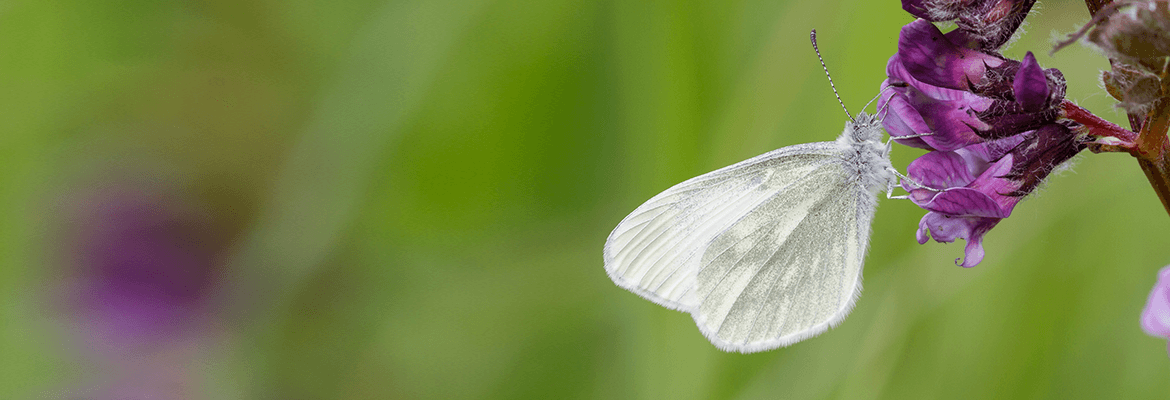
Wingspan
42 mm
Checklist Number
58.002
This is our most recently-discovered butterfly, being almost identical to the Wood White and originally described as Réal's Wood White. However, in 2011 Réal's Wood White was itself split, resulting in another new species - the Cryptic Wood White, a species that is found across Ireland with the exception of the Burren. This species share many characteristics with the Wood White, in terms of both appearance and behaviour. Like the Wood White, adults always rest with their wings closed although, in flight, the male can be distinguished from the female by a black spot at the tip of the forewings that is greatly reduced in the female. This species is only found in Ireland in the British Isles, where it is widespread. Current evidence suggests that there is no overlap in distribution between the Wood White and Cryptic Wood White; the Wood White being confined to areas of the Burren limestone district in Clare and South-east Galway in the west of Ireland.
This species was first defined in Williams (1946) (type locality: Ireland).
Although more analysis needs to be done, it is suspected that (like its close relative, the Wood White) males of any summer brood have darker wing spots than those of the spring brood, whose spots are greyer in colour, and that females of any summer brood are slightly smaller than those of the spring brood.
| Family: | Pieridae | Swainson, 1820 |
| Subfamily: | Dismorphiinae | Schatz, 1887 |
| Tribe: | Leptideini | Verity, 1947 |
| Genus: | Leptidea | Billberg, 1820 |
| Subgenus: | ||
| Species: | juvernica | Williams, 1946 |
Description to be completed.
The distribution data (2000-2009) has been made available through the generosity of Butterfly Conservation and any subspecies distribution is taken from Riley (2007). Click here to see the distribution of this species together with site information overlaid.
The relatively-recent discovery of this butterfly as a separate species from the Wood White has led to difficulties in understanding its true status. However, based on historical evidence, it is believed that this butterfly has been lost from south County Cork, north County Dublin and County Meath. In Northern Ireland, this butterfly is considered a priority species.
The table below shows the occurrence (distribution) and abundance (population) trends, using information from The State of the UK's Butterflies 2015 (Fox, 2015). Any UK BAP status is taken from the UK Biodiversity Action Plan (UK BAP) (2007 review).
1976-2014 (%) | 1976-2014 (%) | 2005-2014 (%) | 2005-2014 (%) | Insufficient Data | Insufficient Data |  -23 -23 | Insufficient Data |
|---|
Adults fly throughout May and into June. There is currently some debate as to whether this species has a partial second brood, with no apparent evidence of such an event.

Males can be found patrolling for females, rarely stopping to rest or feed, especially in sunny weather. On dull days, the butterfly will rest on the underside of a leaf with its wings closed and, when disturbed, will fly into thick undergrowth. Like the Wood White, the courtship of this butterfly is an amazing spectacle. Male and female face each other with wings closed and intermittently flash open their wings. At the same time, the male waves his proboscis and white-tipped antennae either side of the female's head. If the female is receptive to these signals, the female bends her abdomen toward the male and the pair mate, staying coupled for around 30 minutes.
Adults feed primarily on Bush Vetch (Vicia sepium). Common Bird's-foot-trefoil (Lotus corniculatus), Common Vetch (Vicia sativa), Germander Speedwell (Veronica chamaedrys), Hoary Willowherb (Epilobium parviflorum), Meadow Buttercup (Ranunculus acris), Meadow Vetchling (Lathyrus pratensis), Ragged-Robin (Silene flos-cuculi), Red Clover (Trifolium pratense) and Tufted Vetch (Vicia cracca) are also used.
The superbly-camouflaged larva feeds by first eating the tips of the finest shoots, before working its way down the plant. The larva moults 4 times in total.
The primary larval foodplants are Common Bird's-foot-trefoil (Lotus corniculatus), Greater Bird's-foot-trefoil (Lotus pedunculatus), Meadow Vetchling (Lathyrus pratensis) and Tufted Vetch (Vicia cracca).
Description to be completed.
Description to be completed.
Description to be completed.
Description to be completed.
Description to be completed.
The following links provide additional information on this butterfly.